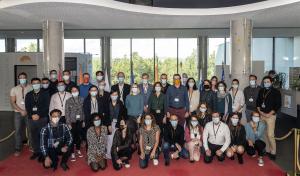E-procurement helps to simplify and streamline
These are document-heavy activities that, in the past, Procurement & Contracts would have managed across a number of internal software platforms. But as part of a new push for corporate digitalization, the division has introduced an e-procurement tool that creates a centralized source for procurement managers, suppliers and ITER stakeholders alike, offering significant synergies and reducing the quantity of manual and repetitive actions.
"As a public organization, ITER needs absolute transparency and traceability in its procurement processes, and we need to be able to prove fair treatment in the competitive process," stresses Christophe Dorschner, who heads the Procurement & Contracts Division. "Everything we can do to streamline and improve our processes helps us to support the delivery of the ITER Project."
The Division's new electronic procurement tool, "I-PROC," is based on SAP's Ariba solution—an industry-standard used widely around the globe. The team has intentionally sought to remain within the boundaries of the tool, instead of creating a bespoke ITER version. "We are adapting our way of working and approach to the tool, instead of the reverse," says Dorschner. "This is time and money saving, and also ensures that we are moving toward simplifying, not complicating, our procurement processes." The team worked with outside consultants to create the initial technical specifications and to configure the tool; it also benefitted from extensive support from ITER's Information Technology (IT) Division.
Daphne Crowther, the Division member responsible for the e-procurement project, emphasizes that less time spent in manual operations related to document management and traceability frees up time for human interaction. "We are bringing more value to the contract negotiation process by focusing on research and supplier sourcing at the front end of each tender, and on negotiation, risk management and efficiency once the supplier has been selected. Having a centralized tool also helps us to better support the contract responsible officers across the organization during the execution of the contract, and facilitates our interaction with ITER stakeholders in the legal, finance, quality project control units."
The roll out of I-PROC began on 15 September in selected departments, part of a phased introduction that will allow the team to clear any bugs in the system—hand in hand with user—as they arise. "We have to train approximately 350 users inside our organization, as well as accompany at least 400 active suppliers during this transition," says Crowther.
Procurement & Contracts describes the adoption of a new e-procurement tool as a "transformative" project that ensures that the ITER Organization is keeping up with best practice in the procurement domain.
"The Procurement & Contracts Division now has a tool that is better suited to the project phase ahead, where we expect lots of intense interaction with suppliers and contract responsible officers, says Nagaich Nalinish, who heads the Corporate Domain. "It is also the first step in a larger corporate effort to advance the digitalization of the ITER Organization, and to simplify and declutter our processes."


